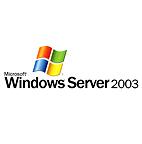Г. В. Царева
 Скачать 1.52 Mb. Скачать 1.52 Mb.
|
1993: Windows NT Advanced Server 3.1Windows NT Advanced Server 3.1 was launched in July 1993 as a dedicated server for a client/server environment. It provided the power, scalability, enhanced fault tolerance, and standards-based interoperability required for enterprise computing. Microsoft promoted Windows NT Advanced Server as an application server for Novell NetWare, Banyan VINES, and Microsoft networks, capable of providing a platform for sophisticated business solutions such as financial, accounting, and vertical applications. As an application server, Windows NT Advanced Server was also a powerful platform for database servers such as Microsoft SQL Server™, communications servers such as Microsoft SNA Server, and mail servers such as Microsoft Mail. For network management, Windows NT Advanced Server provided customers with centralized security and server management, along with graphical tools to manage multiple systems as well as a single logon for enterprise users. In addition, it could run all the applications created for desktop Windows versions. 1994: Windows NT Server 3.5The next release of Windows NT Server was built on the stability of version 3.1, but with greatly enhanced processing speed and improved connectivity to other systems, particularly in Novell NetWare and UNIX environments. Enhancements included new administration tools, improved client software configuration, an auto-reboot and dump facility, better tools for NetWare, and better remote access capabilities. 1995: Windows NT Server 3.51This incremental release of Windows NT Server in June 1995, included a tool to help customers manage Client Access Licenses (CALs) for a suite of server products called the Microsoft BackOffice® family. This release also featured a utility that enabled over-the-network installation of Windows 95. 1996: Windows NT Server 4.0With this upgrade, Windows NT Server gained the popular look and feel of Windows 95 and added many advanced features for business and technical users. Enhancements included: Higher network throughput. Faster file and print services. Robust application support. Standards-based communications features. An integrated Web server, Internet Information Server (IIS) 2.0. Support for the Microsoft FrontPage® Web editing and management tool. A toolset for developing and managing intranets. Subsequent service packs and option packs offered additional features, including public-key and certificate authority functionality, smart card support, improved symmetric multiprocessing (SMP) scalability, clustering capabilities, and component object model (COM) support. 1997: Windows NT Server 4.0, Enterprise EditionWindows NT Server 4.0, Enterprise Edition, built on the strengths of Windows NT Server 4.0 by adding features and capabilities designed to appeal to large corporate customers. Windows NT Server 4.0, Enterprise Edition, added greater performance and scalability, higher availability, and expanded services for developing enterprise applications. The product also included Microsoft Transaction Server to facilitate the development of Internet and intranet applications, and Microsoft Message Queue Server (MSMQ), which enabled applications running at different times to communicate across heterogeneous networks and systems that may be temporarily offline. In October 1998, Microsoft announced that it would drop the “NT” suffix in the next major version of the Windows NT operating system, which would become known as Windows 2000. 1998: Windows NT Server 4.0, Terminal Server EditionWindows NT Server 4.0, Terminal Server Edition gave the Windows NT Server operating system the ability to serve 32-bit Windows operating system-based applications to terminals and terminal emulators running on PC and non-PC desktops. This technology offered a bridge for organizations that were transitioning to a pure 32-bit desktop environment by allowing their existing non-Windows-based computers to connect to a Windows network. 2000: Windows 2000 Server FamilyIn February 2000, Bill Gates unveiled the Windows 2000 client and server family. The client side was represented by Windows 2000 Professional, which went on to become Windows XP Professional. To support businesses of all sizes, three server versions were offered: Windows 2000 Server provided a multipurpose network operating system for departmental file, print, Web, and entry-level application servers. Windows 2000 Advanced Server was designed to support business-critical Web and line-of-business application on a reliable, manageable operating system. Windows 2000 Datacenter Server delivered the highest levels of operating system scalability and availability for the most demanding server applications. For IT professionals, the Windows 2000 Server family introduced new, centralized, policy-based management with Microsoft IntelliMirror® management technologies and the Microsoft Active Directory® directory service. In addition, a high-performance Web server featuring Active Server Pages (ASP) was included, as well as COM+ component services, transaction and message queuing support, and end-to-end XML support. 2  003: Windows Server 2003 003: Windows Server 2003Launched in April 2003, the Windows Server™ 2003 family works as a highly productive infrastructure that helps organizations “do more with less”. The first server operating system to feature built-in Microsoft.NET functionality, Windows Server 2003 delivers significantly greater dependability, security, and scalability compared to earlier versions. Four versions are tailored to the varying needs of organizations: Windows Server 2003, Standard Edition, provides a solution for departmental and standard workloads and supports file and printer sharing, helps secure Internet connectivity, centralizes deployment of desktop applications, and enhances collaboration among employees, partners, and customers. Windows Server 2003, Enterprise Edition, is the platform for mission-critical server workloads. By delivering high reliability, scalability, and performance, it offers a superior value to businesses of all sizes. Windows Server 2003, Datacenter Edition, is designed to support the highest levels of scalability and reliability. Windows 2003, Datacenter Edition, is available in both 32-bit and 64-bit versions through original equipment manufacturer (OEM) partners. Windows Server 2003, Web Edition, a new offering, is a single-purpose operating system for dedicated Web serving and hosting. It provides a platform for rapidly developing and deploying Web services and applications. |
